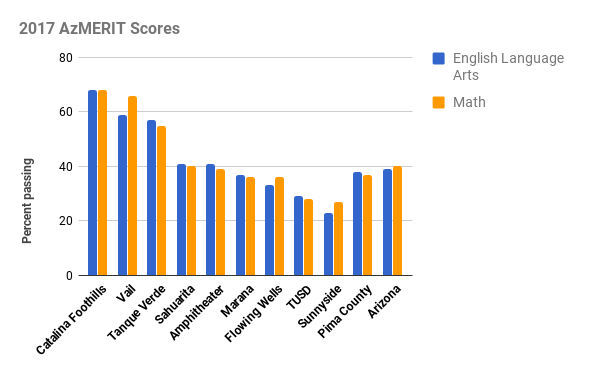Pima County students overall are scoring higher than many of their rural peers on the AzMERIT test, according to official test results released by the Department of Education Wednesday, but Southern Arizona’s largest school district is dragging down the county’s results.
Students in the Tucson Unified School District performed well below the state average on the standardized test and were also outperformed by students in eight of Pima County’s nine major school districts.
AzMERIT, which tests students from third grade up on English language arts and math, was designed to be more difficult and rigorous than the AIMS test it replaced, and the majority of Arizona students have not tested proficient in any subject at any grade level over the last three years it has been administered.
Statewide, 39 percent of students passed the English language arts portion of the AzMERIT test administered last spring, while 40 percent of students passed the math portion of the test. Pima County’s school scores were slightly lower, with 38 percent of Pima County students passing the reading and writing portion of the test, and 37 percent passing the math portion.
Scores for Pima County schools in Fiscal Year 2017.
Scores by county in Fiscal Year 2017.
That put Pima County students near the top of the test scores broken down by county. In math, Pima County students tied for third place among the state’s 15 counties, behind Maricopa and Greenlee counties. In the reading and writing portion of the test, Pima County placed fifth, behind Greenlee, Maricopa, Yavapai and Graham counties.
But Southern Arizona’s largest school district, TUSD, fell way below those numbers.
Only 28 and 29 percent of TUSD students passed the math and English portions of the test, respectively.
TUSD Superintendent Gabriel Trujillo couldn’t be immediately reached for comment, but said in August, after the district saw its unofficial scores, that the results were disappointing.
To turn the scores around, Trujillo said he will emphasize three major points: Teacher training; a focus on early education and increasing K-3 scores; and using intervention methods for middle and high school students who are falling behind.
To that end, he said TUSD will start requiring mandatory teacher training for the district’s curriculum. Additionally, Trujillo wants to enact a “rotation station-based approach” for K-3 students that would allow teachers to break classes into smaller, more manageable groups and offer students who are falling behind in math or language arts special guided instruction, while other students who are already succeeding do more self-guided study. Finally, he wants to implement an intervention for high school students who are falling behind on math and language arts that would take students out of their normal classroom for special instruction until they catch up.
The test results were even worse for Sunnyside Unified School District, which scored the lowest of any of Pima County’s nine major districts, with only 27 and 23 percent of students passing the math and English language arts portions of the test, respectively.
Victor Mercado, Sunnyside spokesman, said the results show Tucson’s second-largest district isn’t where it wants to be — though he was happy with some of the improvements in subgroups of students over past years, such as an increase in third- and fifth-grade math scores.
But Mercado acknowledged that the district has a long way to go to compete with its neighboring districts, some of which have twice the percentage of students passing AzMERIT. To close that gap, he said the district last year made significant changes to its curriculum that officials hope will help boost student performance over time. And he noted that Sunnyside faces external factors that make it hard to compete with other districts — it’s one of the poorer districts in Pima County and has a large number of English language learners.
But Mercado said standardized tests aren’t everything, and other data points, such as graduation rates or parent satisfaction, offer a fuller analysis of the district.
“It’s just one data point we have. There are other ways to measure growth that might not be as obvious,” he said.
The highest scoring district in Pima County, Catalina Foothills School District, had 68 percent of its students pass both the math and English portion of the test — a score that Assistant Superintendent Mary Jo Conery said reflects the district’s commitment to rigorous curriculum in schools, ongoing evaluations for its students and professional development for teachers.
She noted that teachers and administrators spent the past two years collaboratively developing a curriculum that considers the end goal and works backwards from there to achieve that goal. And Catalina Foothills has developed its own performance assessments to measure student achievement and growth.
She said the district focuses on not just if the students can learn the standards, but can apply what they’ve learned in real life.
Conery, too, said standardized tests aren’t everything, but that Catalina Foothills’ results reflect the hard work teachers, administrators and students put into the district.
“The work that we do is not towards the end result of AzMERIT.... But we believe that this work is benefitting what students are being asked to do on AzMERIT,” she said.
Arizona charter schools outperformed traditional district schools, with 48 and 47 percent of charter students passing language arts and math, respectively, compared to 37 and 39 percent of district students.
The passing rate for all schools statewide improved by 1 percentage point in English language arts and 2 percentage points in math, something Arizona schools chief Diane Douglas praised, saying “students are modestly moving in the right direction.”
Douglas, however, railed against “overtesting,” saying valuable instructional time is lost and schools should be able to choose from a menu of assessments, with one option allowing parents to opt out of AzMERIT altogether.
“I believe Arizona’s children and educational system are much better than the scores indicated by AzMERIT,” she said.





